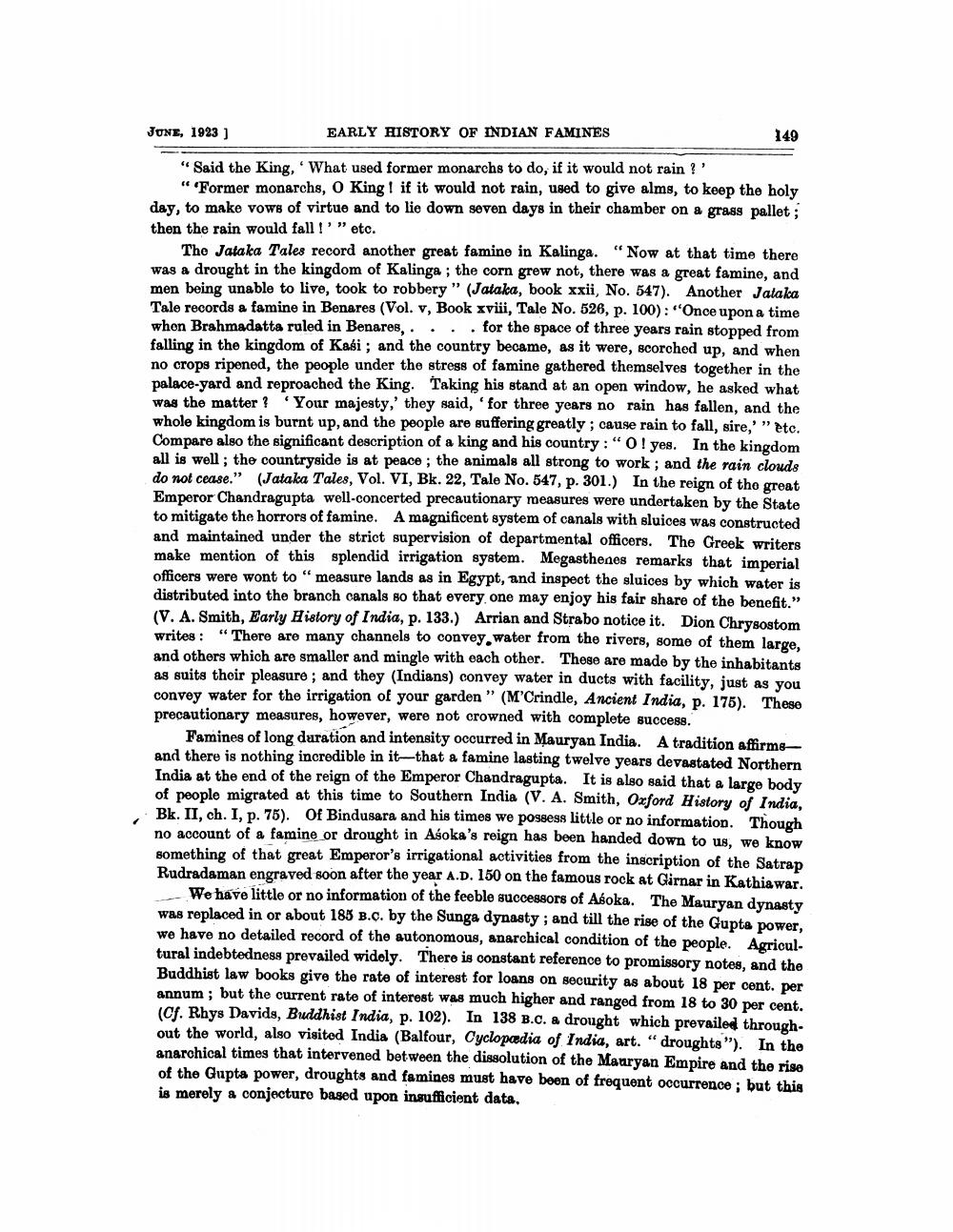________________
JUNE, 1923)
EARLY HISTORY OF INDIAN FAMINES
"Said the King, What used former monarchs to do, if it would not rain!'
" 'Former monarchs, O King 1 if it would not rain, used to give alms, to keep the holy day, to make vows of virtue and to lie down seven days in their chamber on a grass pallet; then the rain would fall!'" etc.
The Jataka Tales record another great famine in Kalinga. “Now at that time there was a drought in the kingdom of Kalinga ; the corn grew not, there was a great famine, and men being unable to live, took to robbery” (Jataka, book xxii, No. 547). Another Jataka Tale records a famine in Benares (Vol. v, Book xviii, Tale No. 526, p. 100): "Once upon a time when Brahmadatta ruled in Benares, . . . . for the space of three years rain stopped from falling in the kingdom of Kabi; and the country became, as it were, scorched up, and when no crops ripened, the people under the stress of famine gathered themselves together in the palace-yard and reproached the King. Taking his stand at an open window, he asked what was the matter? 'Your majesty,' they said, 'for three years no rain has fallen, and the whole kingdom is burnt up, and the people are suffering greatly; cause rain to fall, sire,'" etc. Compare also the significant description of a king and his country: "O! yes. In the kingdom all is well; the countryside is at peace; the animals all strong to work ; and the rain clouds do not cease." (Jataka Tales, Vol. VI, Bk. 22, Tale No. 547, p. 301.) In the reign of the great Emperor Chandragupta well-concerted precautionary measures were undertaken by the State to mitigate the horrors of famine. A magnificent system of canals with sluices was constructed and maintained under the strict supervision of departmental officers. The Greek writers make mention of this splendid irrigation system. Megasthenes remarks that imperial officers were wont to "measure lands as in Egypt, and inspect the sluices by which water is distributed into the branch canals so that every one may enjoy his fair share of the benefit." (V. A. Smith, Early History of India, p. 133.) Arrian and Strabo notice it. Dion Chrysostom writes: "There are many channels to convey. water from the rivers, some of them large, and others which are smaller and mingle with each other. These are made by the inhabitants as suits their pleasure, and they (Indians) convey water in ducts with facility, just as you convey water for the irrigation of your garden " (M'Crindle, Ancient India, p. 175). These precautionary measures, however, were not crowned with complete success.
Famines of long duration and intensity occurred in Mauryan India. A tradition affirmeand there is nothing incredible in it--that a famine lasting twelve years devastated Northern India at the end of the reign of the Emperor Chandragupta. It is also said that a large body of people migrated at this time to Southern India (V. A. Smith, Oxford History of India, Bk. II, ch. I, p. 75). Of Bindusara and his times we possess little or no information. Though no account of a famine or drought in Asoka's reign has been handed down to us, we know something of that great Emperor's irrigational activities from the inscription of the Satrap Rudradaman engraved soon after the year A.D. 150 on the famous rock at Girnar in Kathiawar.
We have little or no information of the feeble successors of Asoka. The Mauryan dynasty was replaced in or about 185 B.c. by the Sunga dynasty; and till the rise of the Gupta power, we have no detailed record of the autonomous, anarchical condition of the people. Agricul. tural indebtedness prevailed widely. There is constant reference to promissory notes, and the Buddhist law books give the rate of interest for loans on security as about 18 per cent. per annum ; but the current rate of interest was much higher and ranged from 18 to 30 per cent. (Cf. Rhys Davids, Buddhist India, p. 102). In 138 B.C. a drought which prevailed through out the world, also visited India (Balfour, Cyclopaedia of India, art. "droughts"). In the anarchical times that intervened between the dissolution of the Mauryan Empire and the rise of the Gupta power, droughts and famines must have been of frequent occurrence ; but this is merely a conjecture based upon insufficient data.




